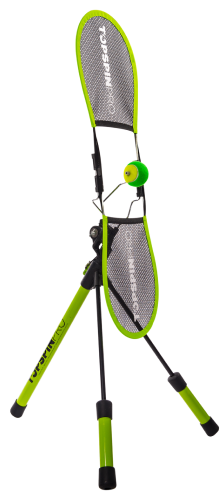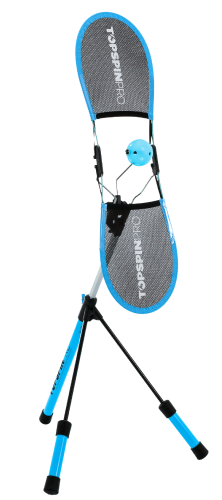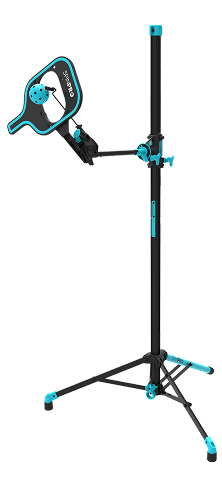
Stay in the loop!
Want to be updated when we publish? Be sure to sign up for our newsletter. No spam, we promise!
Adding topspin to your pickleball dinks enhances control and keeps your opponent guessing. While a traditional dink is meant to keep the ball low and soft, a topspin dink allows for a more aggressive approach enabling you to add pace and height and sharply drop the ball at your opponent's feet. This creates an unpredictable bounce that’s challenging to handle. In this article, we’ll explore the mechanics of the topspin dink, identify when it can give you an edge, and provide drills to help you master this powerful shot.
What is a Topspin Dink?
In pickleball, a "dink" is a soft, controlled shot aimed at landing in your opponent's non-volley zone (NVZ), also called the "kitchen." Within this zone, players cannot volley and must let the ball bounce before hitting it. The purpose of a well-placed dink is to keep your opponent from attacking, forcing them into a controlled shot with a higher chance of a pop-up, giving you an opportunity to take the offensive.
A topspin dink elevates the standard dink by adding spin and a bit more power. The topspin causes the ball to arc over the net and dip quickly, often creating a challenging bounce for your opponent. This also means you can hit the ball harder. Unlike a typical dink that stays low without spin, the topspin dink introduces an unpredictable trajectory and bounce, making it more difficult for your opponent to return effectively.
Why Hit a Topspin Dink?
Adding topspin to your dinks can elevate your game by creating unique challenges for your opponents. Here are several reasons why topspin dinks are so effective and why they’re worth incorporating into your strategy:
1. Add More Pace
Topspin lets you hit the ball harder and higher while still controlling it within the same target zone as a softer, flat shot (see image below). By adding more power with topspin, you make the ball more challenging to return and reduce your opponent's reaction time, often leading to rushed decisions and weaker returns.

2. Creates Unpredictable Bounces
Topspin makes the flight path of the ball arc over the net and then dip sharply (see image above). This can create a challenging bounce that’s harder for your opponent to predict and control. Unlike a flat dink, which has a straightforward bounce, a topspin dink can kick up or to the side, depending on the part of the ball you strike, forcing your opponent to adjust quickly. This unpredictability often results in weak returns and pop-ups.
3. Forces Opponents to Play More Defensively
Topspin makes the ball kick up higher after the bounce than an equivalent flat shot. So a well-executed topspin dink can push your opponent back from the kitchen line, forcing them to play defensively. With the ball kicking up higher, they’ll have to adjust their paddle angle and foot positioning, often causing them to hit off-balance or under pressure. This defensive response can prevent them from attacking and allow you to dictate the rally.
4. Enhances Control
The spin you generate on a topspin dink gives you better control over the ball’s placement and depth. Topspin makes the ball dip faster and therefore you are less likely to hit the ball too high into your opponent's strike zone.
5. Keeps Opponents Guessing
One of the biggest advantages of the topspin dink is that it adds variety to your shot selection, keeping your opponent guessing. When you mix topspin dinks with regular dinks, your opponent has to be on alert, as they can’t assume the ball will react predictably.
Topspin Dink Technique
Mastering the topspin dink requires a combination of good grip, precise paddle movement, and body positioning. Here’s a step-by-step guide:
1. Grip
Forehand: Use the Continental Grip or the Eastern Forehand for the easiest control and execution of the dink.
Backhand: Use a standard two-handed backhand grip or for a one-hander use a Continental grip or Eastern Backhand grip.
Here's a grip guide if you are unsure how to find these:


2. Stance
Try to maintain a balanced stance when hitting. Avoid crossing over your legs to reach a wide ball. This will cause your shoulders to turn away from the ball making you vulnerable to attack. Use a shuffle step to reach wide balls.
3. Swing Path
Your motion should be low to high to help generate topspin but try to keep the swing compact. When you are close to your opponents at the kitchen a long swing path won't give you time to recover before your next shot. Keep the paddle speed controlled and medium pace. If you swing too slow you will lose topspin and too fast you will lose control.
See the video below for the best way to practice at home on the TopspinPro:
When to Use the Topspin Dink
The topspin dink isn’t a shot to use for every dink. It’s most effective when you need to put your opponent on the defensive or disrupt their rhythm by mixing up your dinks. Having a mixture of flat, slice, and topspin dinks will keep them on their toes!
Here are a few ideal situations to use your topspin dink:
1. When Your Opponent Doesn't Like Topspin
It can quickly become apparent if one or even two of your opponents don't like topspin dinks. In this situation, you will notice more returned dinks in the net and your opponent stepping away from the kitchen line to give themselves more time to react. If you see a level of panic happening then capitalize on it by keeping the topspin coming.
2. When Your Opponent Stands Too Close
If your opponent is crowding the net and pushing close to the kitchen line, a topspin dink can cut down their reaction time, push them back, and disrupt their aggressive positioning. The extra topspin can therefore force a weak return or an error.
3. Against Opponents Who Struggle With Movement
Players who struggle with footwork may find the topspin dink especially hard to handle. The bounce forces them to move quickly and adjust, which can lead to mistakes or poor positioning which can open up spaces to attack.
4. To Mix Up Your attack
Mixing topspin with flatter dinks and even slices changes the trajectory and forces your opponent to adjust, often causing them to misjudge the shot or hit a short return. By keeping them guessing you are preventing them from getting into a rhythm with their shots.
How to Practice Your Topspin Dinks
To integrate the topspin dink into your game, practice is essential. Here are some effective drills to help you improve control, consistency, and confidence with this shot:
1. Use A TopspinPro
The SpinPro or TopspinPro is a great way to build up your biomechanical efficiency and the correct technique. By practicing with a stationary ball you remove the pressure of an incoming ball. This is the best way to get good-quality repetitions.
2. Wall Drills
The wall is the best way to build up consistency with a moving ball as the ball always comes back...unless you have a low wall! Measure 7 feet from the wall so you are the correct distance away. You can even add some targets to work on accuracy.
3. Partner Practice
Once you have a good reliable technique it's a good idea to start practicing with a partner. This is a great way to practice realistic shots where you might be a little under pressure.
Here's a great drill for beginners but is also useful for all levels of players to build up their control:
Master Technique With The SpinPro
If you want to add more spin to your game or master certain techniques try the SpinPro. It's a simple and effective way to learn the correct biomechanics without the pressure of an incoming ball!


Conclusion
The topspin dink is a powerful addition to any pickleball player’s arsenal. By combining the finesse of a traditional dink with the added control and bounce of topspin, you can add variety, create opportunities, and keep your opponents on the defensive. With proper technique, practice, and strategic use, the topspin dink can become a reliable tool that enhances your control of the game.
FAQs
-
What is a topspin dink in pickleball?
A topspin dink is a pickleball shot that combines the finesse of a soft dink with added power and spin. It causes the ball to arc over the net and dip quickly, creating a difficult bounce for the opponent to handle.
-
Why should I use a topspin dink?
Using a topspin dink can elevate your game by adding pace and unpredictability, forcing opponents to play defensively. It enhances control, creates unique challenges, and keeps your opponents guessing with varied shot selection.
-
What technique is recommended for a topspin dink?
Mastering the topspin dink requires a good grip, balanced stance, and a controlled swing path. Use the Continental or Eastern grip, maintain a balanced stance, and execute a low-to-high swing to generate topspin without losing control.
-
When is the best time to use a topspin dink?
The topspin dink is most effective against opponents who struggle with topspin, stand too close to the net, or have poor movement. It’s also useful for disrupting opponents’ rhythm by mixing different dink types.
-
How can I practice topspin dinks effectively?
Practice topspin dinks using tools like the TopspinPro to refine technique, wall drills to build consistency, and partner practice for realistic scenarios. These drills help improve control, consistency, and confidence in using topspin dinks.
Links Related to This Article
Enjoyed this article?
Be sure to sign up for our newsletter and we'll keep you up to date about new posts



